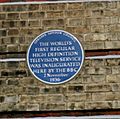Commemorative plaque facts for kids

A commemorative plaque is like a special sign or plate. It's usually made of metal, ceramic, stone, or wood. You often see them placed on walls or big stones. These plaques have text and sometimes pictures. They help us remember important people, events, or what a place was used for a long time ago. A very small plaque is sometimes called a plaquette, but this word isn't usually used for the plaques you see outside on buildings.
Contents
Plaques in the United Kingdom
In England, there's a famous program called the Blue Plaque scheme. Under this program, special blue plaques are put on buildings. They celebrate the connection between the building and important people or events that happened there.
History of Blue Plaques
The Blue Plaque scheme has been managed by an organization called English Heritage. It has been around for over 140 years! Many people believe it's the oldest program of its kind in the world.
Other Plaque Programs
Besides the Blue Plaque scheme, many local councils and charities across the United Kingdom also put up commemorative plaques. Each of these groups has its own rules for deciding where and when to place a plaque.
Plaques as Awards
Sometimes, plaques (or smaller ones called plaquettes) are given out as awards. They are used instead of trophies or ribbons. These award plaques usually have text that explains why the award was given and the date it was presented.
Images for kids
-
A plaque honoring Claude Bernard in Paris, France.
-
This sign in Dickson, Australian Capital Territory remembers Canberra's first aerodrome and its first accident in the 1920s.
-
Sir Henry Cole helped start the first historical marker program in 1866.
-
This Greater London Council blue plaque at Alexandra Palace celebrates the start of BBC Television in 1936.
-
These historical markers show where the Francis Parkman House is located. It's a National Historic Landmark on Beacon Hill in Boston, Massachusetts.
See also
 In Spanish: Placa conmemorativa para niños
In Spanish: Placa conmemorativa para niños








